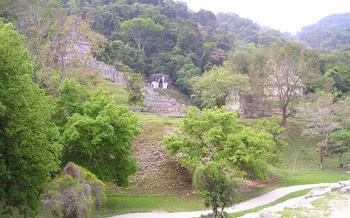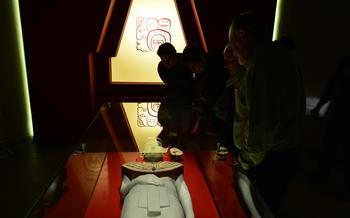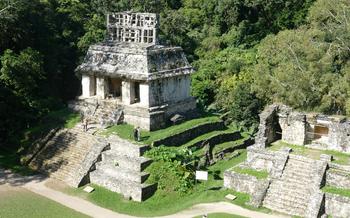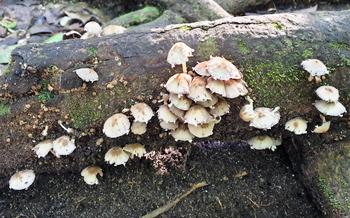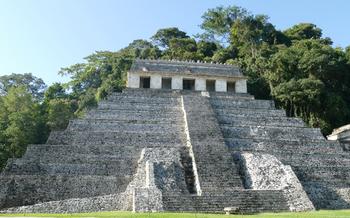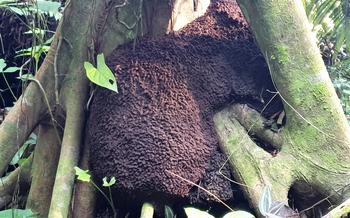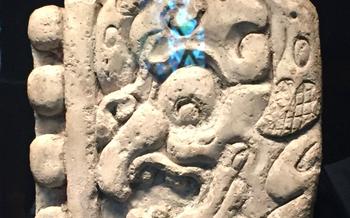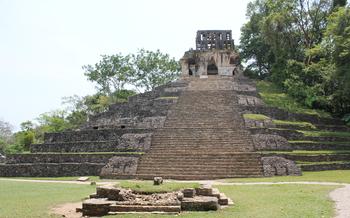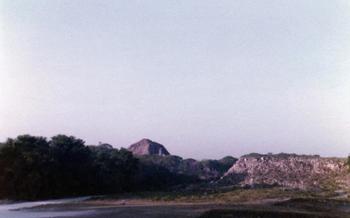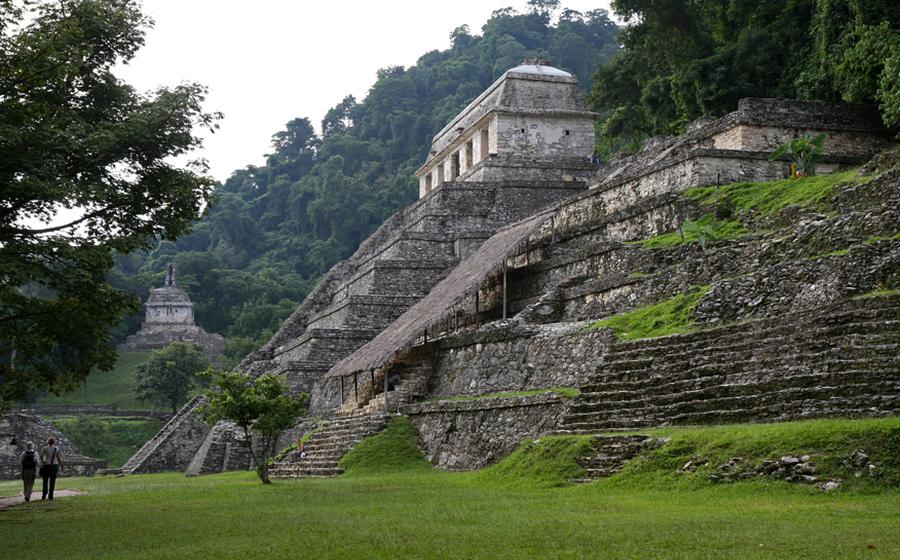
Templo de las Inscripciones
- The Antiquity of Palenque
- Templo de las Inscripciones
- Inside the Temple
- Pakal the Great
- Maya Hieroglyphs
- Maya Architecture
- Sacred Rituals
- Palenque National Park
- Photography and Videography
- Local Culture and Cuisine
- Sustainable Tourism
- Safety and Security
- Nearby Attractions
- Insider Tip: Unveiling the Hidden Gem of Templo XIX
The Antiquity of Palenque
Amidst the lush rainforests of Chiapas, Mexico, lies the ancient Maya city of Palenque, a testament to the ingenuity and grandeur of one of the most advanced civilizations of pre-Columbian America. Inhabited from around 100 BC to 800 AD, Palenque reached its peak during the Classic period (250-900 AD) and played a pivotal role in the Maya world. Archaeological discoveries continue to shed light on the city's rich history, revealing intricate social structures, advanced agricultural practices, and a sophisticated understanding of astronomy and mathematics. Among the most renowned explorers who visited Palenque were John Lloyd Stephens and Frederick Catherwood, whose 1841 expedition brought the city's ruins to the attention of the world. Their vivid accounts and detailed drawings ignited a fascination with Palenque that endures to this day.
Templo de las Inscripciones
The Templo de las Inscripciones, or Temple of the Inscriptions, stands as a testament to the architectural prowess and cultural significance of the ancient Maya civilization. This pyramid-shaped temple, nestled within the heart of Palenque, is renowned for its intricate carvings, hieroglyphic inscriptions, and the remarkable discovery of Pakal the Great's tomb beneath its sacred chambers.
The temple's design showcases the Maya's mastery of construction techniques. Its towering structure, adorned with intricate stone carvings, depicts scenes from Maya mythology, historical events, and the life of Pakal the Great. The temple's facade is adorned with hieroglyphic inscriptions that narrate the history of Palenque and provide valuable insights into the Maya civilization's political, social, and religious practices.
In 1952, Mexican archaeologist Alberto Ruz Lhuillier made a groundbreaking discovery beneath the temple. He unearthed a hidden staircase leading to a subterranean chamber, where the elaborately carved stone sarcophagus of Pakal the Great lay undisturbed. The sarcophagus, adorned with intricate carvings and a depiction of Pakal's journey to the afterlife, is considered one of the most significant archaeological finds of the 20th century.
The discovery of Pakal's tomb and the wealth of information gleaned from the temple's inscriptions have shed new light on the Maya civilization, providing valuable insights into their beliefs, rituals, and history. The Templo de las Inscripciones stands as a symbol of the Maya's cultural achievements and serves as a reminder of the enduring legacy of this ancient civilization.
Inside the Temple
Descending into the temple's tomb is a thrilling yet daunting experience. A narrow staircase, dimly lit by the flickering light of a flashlight, leads visitors deep into the heart of the pyramid. The air is thick with humidity and the musty scent of ancient stone.
At the bottom of the staircase lies the magnificent stone sarcophagus of Pakal the Great. Carved from a single block of limestone, the sarcophagus is adorned with intricate carvings depicting Pakal's journey to the afterlife. The lid of the sarcophagus features a full-body portrait of Pakal, wearing an elaborate headdress and surrounded by symbols of Maya mythology.
The walls of the tomb are covered in vibrant murals and paintings, depicting scenes from Maya mythology and rituals. These murals offer a glimpse into the beliefs and practices of the ancient Maya, providing valuable insights into their worldview and spiritual traditions.
The tomb of Pakal the Great is not just a burial chamber but a sacred space that holds profound spiritual and symbolic significance for the Maya civilization. It represents the transition from the physical world to the realm of the gods, embodying the Maya belief in the cyclical nature of life and death.
Pakal the Great
Pakal the Great, born in 603 AD, reigned over Palenque for an impressive 68 years. During his lifetime, he transformed the city into a thriving metropolis, leaving an indelible mark on Maya history. Pakal's reign was marked by significant construction projects that expanded the city and showcased his architectural prowess. Under his patronage, Palenque's most iconic structures, including the Templo de las Inscripciones, were erected.
Pakal's contributions extended beyond architecture. He was a skilled diplomat who forged alliances with neighboring city-states, ensuring peace and stability in the region. His rule ushered in a period of cultural and intellectual flourishing, as evidenced by the exquisite carvings, hieroglyphics, and murals found throughout Palenque.
Choosing the Templo de las Inscripciones as his final resting place was a testament to Pakal's desire to be remembered as a revered and powerful ruler. His massive stone sarcophagus, intricately carved with scenes of his life and journey to the afterlife, stands as a symbol of his greatness and his enduring legacy.
Theories and controversies surround Pakal's rule and legacy. Some scholars believe he may have been a divine king, revered as a demigod by his people. Others suggest that he was an enlightened ruler who embraced astronomical knowledge and scientific advancements. The ongoing study of Palenque and its artifacts continues to shed light on Pakal's reign, providing valuable insights into Maya civilization and the life of one of its most enigmatic rulers.
Maya Hieroglyphs
The Maya Hieroglyphs
The Templo de las Inscripciones is adorned with intricate hieroglyphs, a form of writing developed by the ancient Maya civilization. These hieroglyphs were used to record historical events, religious rituals, and the lives of Maya rulers. The decipherment of Maya hieroglyphs has been a challenging task for scholars, but significant progress has been made in recent decades.
The inscriptions found on the Templo de las Inscripciones have played a crucial role in understanding Maya history. They provide detailed accounts of the lives and reigns of Maya rulers, as well as insights into the political, social, and cultural aspects of Maya society. The temple's hieroglyphs have also shed light on Maya religious beliefs and rituals, including the importance of the Templo de las Inscripciones as a sacred site.
One of the most notable researchers who dedicated his life to deciphering Maya hieroglyphs was Heinrich Berlin. A German-born scholar, Berlin spent decades studying the inscriptions at Palenque and other Maya sites. His work laid the foundation for the modern understanding of Maya hieroglyphs and helped to unlock the secrets of this ancient civilization.
Through the efforts of Berlin and other scholars, the hieroglyphs of the Templo de las Inscripciones have become a valuable source of information about Maya history and culture. These inscriptions provide a window into the world of the ancient Maya, allowing us to glimpse their beliefs, their rituals, and their way of life.
Maya Architecture
The Templo de las Inscripciones showcases the unique architectural style of the Maya civilization. The Maya were master builders, and their architecture is characterized by its use of corbelled arches, stepped pyramids, and intricate carvings. Corbelled arches are formed by stacking stones or bricks in a way that creates an arch without the use of a keystone. Stepped pyramids were used as temples and platforms for religious ceremonies. The intricate carvings on Maya buildings often depicted gods, rulers, and scenes from mythology.
The Templo de las Inscripciones is a prime example of Maya architecture. The temple is built on a stepped pyramid, and its facade is covered in intricate carvings. The carvings depict scenes from Maya mythology, as well as hieroglyphs that record the history of the city. The temple is also home to the tomb of Pakal the Great, one of the most famous Maya rulers. The tomb is located beneath the temple, and it is decorated with elaborate carvings and paintings.
Maya architecture is not only beautiful, but it is also highly functional. The Maya used their knowledge of engineering and mathematics to create buildings that were both strong and durable. Many Maya buildings have survived for centuries, despite being exposed to the elements and to the ravages of time.
The Maya architectural style is unique among the ancient civilizations of Mesoamerica. It is a testament to the ingenuity and creativity of the Maya people.
Sacred Rituals
The Templo de las Inscripciones held immense religious and ceremonial significance for the ancient Maya. It served as a sacred space where priests and rulers performed elaborate rituals and ceremonies to honor their gods, seek guidance, and connect with the spiritual realm. The temple's intricate carvings and iconography depict scenes of Maya mythology, rituals, and deities, offering a glimpse into their complex belief system.
One of the most important rituals performed within the temple was the enthronement of new rulers. During this sacred ceremony, the ruler would ascend the temple steps, entering the tomb of Pakal the Great to receive divine blessings and legitimacy. This ritual symbolized the continuity of power and the connection between the living ruler and the revered ancestors.
The Maya also believed that the temple served as a portal to the underworld. Through rituals and ceremonies, they sought to communicate with the spirits of their deceased rulers and ancestors, asking for guidance, protection, and intervention in times of need. These rituals were often accompanied by offerings of food, incense, and other sacred objects, placed within the tomb or burned outside the temple.
The Templo de las Inscripciones remains a place of spiritual significance for the modern-day Maya. Contemporary Maya communities often visit the temple to pay homage to their ancestors, perform rituals, and seek blessings. These visits serve as a bridge between the past and the present, connecting the living with the legacy of their ancient civilization.
Palenque National Park
The Templo de las Inscripciones is situated within the breathtaking Palenque National Park, a UNESCO World Heritage Site renowned for its diverse natural beauty. The park encompasses a vast expanse of lush rainforest, home to an incredible array of flora and fauna. Visitors can explore a network of well-maintained trails that wind through the jungle, offering opportunities to spot monkeys, toucans, and other exotic wildlife. The park also features several waterfalls, including the stunning Misol-Ha waterfall, which cascades into a refreshing pool surrounded by lush vegetation.
To fully appreciate the park's natural wonders, consider hiring a local guide who can lead you to hidden spots and share their knowledge of the local ecosystem. Remember to pack comfortable shoes, insect repellent, and plenty of water for your jungle adventure. Also, be mindful of the park's conservation efforts and avoid disturbing wildlife or leaving any trash behind. By embracing sustainable tourism practices, you can help preserve the beauty and biodiversity of this remarkable natural sanctuary.
Photography and Videography
The Templo de las Inscripciones presents a captivating subject for photographers and videographers, inviting them to capture the essence of this ancient wonder. To ensure a respectful and responsible approach, visitors should adhere to the following guidelines:
-
Respectful Photography: Visitors are kindly requested to be mindful of other visitors while taking photographs or videos, ensuring that their actions do not disrupt or obstruct the experience of others. Using flash photography is discouraged, as it can be disruptive and damaging to the temple's delicate interior.
-
Tripod Usage: Tripods are generally permitted within the temple, but their use should be considerate of other visitors and the overall flow of traffic. Positioning the tripod in a way that obstructs pathways or blocks the view of others should be avoided.
-
Drone Regulations: The use of drones within the Templo de las Inscripciones is strictly prohibited. Drones can be disruptive to the serene atmosphere of the temple and pose a potential safety hazard to visitors and wildlife.
-
Capturing Unique Perspectives: To capture unique and memorable shots, photographers can explore different angles and vantage points around the temple. Climbing or standing on structures is not permitted, but visitors can utilize the surrounding terrain to find elevated or creative angles.
-
Preserving the Temple's Integrity: Visitors are reminded that the Templo de las Inscripciones is a UNESCO World Heritage site and should be treated with the utmost respect. Damaging or defacing the temple or its surroundings is strictly prohibited.
By following these guidelines, visitors can contribute to the preservation of this iconic landmark while capturing stunning images that will serve as lasting mementos of their visit to the Templo de las Inscripciones.
Local Culture and Cuisine
The city of Palenque and its surrounding region are home to a vibrant and diverse culture, deeply rooted in ancient Maya traditions. Visitors to the Templo de las Inscripciones can immerse themselves in this rich cultural heritage through various experiences.
The city of Palenque is alive with local traditions and customs that reflect the unique identity of the region. Visitors can witness traditional Maya dances, listen to enchanting music played on indigenous instruments, and participate in colorful festivals that celebrate local history and heritage.
The cuisine of Palenque is a culinary delight, showcasing a blend of Maya and Mexican flavors. Traditional Maya dishes, such as pochta (a slow-cooked pork stew) and tamalitos (corn-based dumplings), are a must-try for food enthusiasts. Local markets offer a vibrant array of fresh produce, spices, and handmade crafts, providing a glimpse into the daily lives of the local community.
To experience the authentic flavors of Palenque, visitors can venture into the city's charming restaurants, where they can savor traditional dishes prepared with fresh local ingredients. Many restaurants offer outdoor seating, allowing diners to enjoy their meals amidst the lush greenery and serene ambiance of the city.
Sustainable Tourism
Palenque, like many other popular tourist destinations, faces the challenge of balancing tourism development with environmental conservation and the well-being of local communities. Sustainable tourism practices are crucial to minimize negative impacts and ensure the long-term preservation of the Templo de las Inscripciones and its surroundings.
When visiting Palenque, consider the following tips to be a responsible traveler:
-
Choose local guides and tour operators: Opt for locally owned and operated tour companies that support the local economy and have a vested interest in preserving the region's cultural and natural heritage.
-
Respect the environment: Avoid littering, damaging plants, or disturbing wildlife. Follow designated trails and avoid exploring fragile areas.
-
Support local businesses: Shop at local markets, eat at traditional restaurants, and stay in locally-owned hotels or guesthouses to directly benefit the community.
-
Learn about Maya culture: Engage with local Maya communities, attend cultural events, and learn about their traditions and history. This helps promote cross-cultural understanding and supports cultural preservation.
-
Reduce your carbon footprint: Consider offsetting your travel emissions by supporting carbon reduction projects or choosing transportation options that minimize your environmental impact.
By practicing sustainable tourism, you can contribute to the preservation of Palenque's natural and cultural treasures while ensuring that future generations can enjoy this extraordinary destination.
Safety and Security
Palenque is generally considered a safe destination for travelers, but as with any tourist destination, it is essential to exercise caution and take necessary precautions. Here are some safety tips to keep in mind:
-
Be aware of your surroundings: Avoid walking alone at night, especially in secluded areas. Stay alert and be mindful of people approaching you or trying to distract you.
-
Protect your belongings: Keep your valuables, such as your passport, money, and credit cards, secure. Use a money belt or a hidden wallet to prevent pickpocketing.
-
Be cautious of scams: Be wary of individuals offering unsolicited services or tours. Always ask for official identification and inquire about prices and services before committing.
-
Respect local customs: Dress modestly and be respectful of local traditions and customs. Avoid wearing revealing clothing or engaging in behavior that may be considered offensive.
-
Heed safety instructions: Follow the instructions and advice provided by your tour guide or the local authorities. Be aware of any potential risks or hazards associated with certain activities or areas.
-
Support local authorities: If you witness any suspicious activity or feel unsafe, do not hesitate to report it to the local authorities or tourist police. They are there to assist and protect visitors.
Nearby Attractions
Beyond the captivating allure of the Templo de las Inscripciones, Palenque and its surroundings offer a treasure trove of additional attractions that beckon the curious traveler. The ancient Maya city of Yaxchilán, nestled deep within the Lacandon rainforest, invites visitors to explore its impressive ruins, adorned with intricate carvings that narrate tales of a bygone era. Bonampak, another hidden gem, boasts remarkably preserved murals that offer a glimpse into the vibrant world of the ancient Maya.
Nature enthusiasts will find solace and wonder in the Agua Azul waterfalls, a series of cascading turquoise pools surrounded by lush vegetation. The Misol-Ha waterfall, with its powerful plunge into a natural pool, offers a refreshing respite from the tropical heat. For those seeking a more immersive experience, guided tours delving into the history and culture of the region are readily available.
To fully appreciate the richness of Palenque and its surroundings, consider crafting a comprehensive itinerary that allows ample time to explore these captivating attractions. Whether your interests lie in ancient history, natural beauty, or cultural immersion, this region promises an unforgettable journey through time and tradition.
Insider Tip: Unveiling the Hidden Gem of Templo XIX
Amidst discovery: Templo XIX. This unassuming structure, tucked away in the heart of the ruins, offers a unique glimpse into the lives of Palenque's ancient inhabitants. As you venture off the beaten path, you'll encounter a beautifully preserved temple adorned with intricate carvings and vibrant colors. The serene atmosphere invites contemplation and allows you to connect with the spirit of this ancient civilization. Take your time to explore the temple's interior, where you can marvel at the well-preserved murals depicting scenes from Maya mythology. Templo XIX is a testament to the artistry and craftsmanship of the Maya people and offers a glimpse into their rich cultural heritage. Whether you're a history buff, an architecture enthusiast, or simply seeking a moment of tranquility, Templo XIX is a hidden gem that will leave you in awe.
